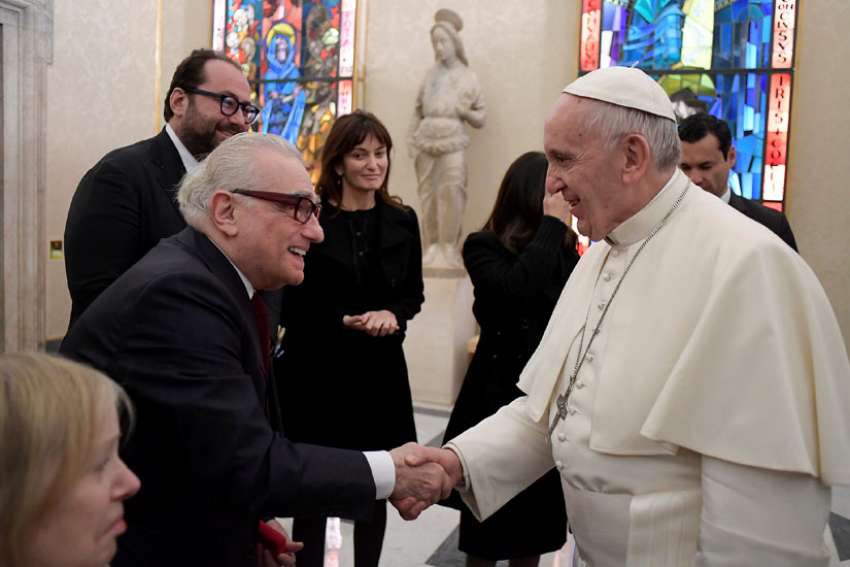Based on a Japanese historical fiction novel recounting Christian persecution in Japan during the 17th century, Silence will hit theaters in December and recounts the story of two Jesuit priests who travel to Japan in the midst of the violence to search for the missing mentor, played by Liam Neeson.
According to a Nov. 30 communique from the Vatican, Scorsese, his wife and their two children were present for the meeting with Pope Francis, alongside the film’s producer and his wife. Msgr. Dario Edoardo Vigano, Prefect of the Secretariat for Communications, accompanied the group.
Described in the communique as “very cordial,” the meeting lasted about 15 minutes. The Pope told his guests that he had read the 1966 novel Silence, written by Japanese author Shusaku Endo and which served as the inspiration for Scorsese’s new movie.
Francis then spoke of the “sowing” of the faith Jesuits did in Japan and of the “Museum of the 26 Martyrs,” which was built on Nishizaka Hill in 1962 alongside a monument commemorating the 100th anniversary of the canonization of the 26 martyrs executed at the site in 1597.
During the brief meeting Scorsese gifted the Pope with two paintings related to the theme of “hidden Christians.” One of them depicts a highly venerated image of the Virgin Mary painted by a Japanese artist in the 18th century. Pope Francis, on his part, gave his guests rosaries.
Other Hollywood biggies Pope Francis has met include Angelina Jolie and Leonardo DiCaprio, who came to the Vatican to speak with the Pope about climate change following the release of Francis’ 2015 environmental encyclical Laudato si.
A preview of Silence was shown Nov. 29 at the Pontifical Oriental Institute in Rome, and another preview is set to take place Dec. 1 inside the Vatican’s filmoteca.
Scorsese, who grew up Catholic and spent a year in seminary as a youth, has made other religious films in the past.
His latest was the controversial 1988 movie “The Last Temptation of Christ,” which was based on an adaption of the novel by Nikos Kazantzakis and focused on Christ’s humanity and emotional suffering, rather than the physical pain he endured. The film was heavily criticized as “sacrilegious” by many in the U.S. and abroad, including by several bishops, by St. Teresa of Calcutta and by Mother Angelica.
Regarding the Catholic faith in Japan, it arrived to the country during the 16th century through the efforts of the Jesuit missionary Saint Francis Xavier (1506-1552). Jesuit outreach to the Japanese continued after his death, and around 200,000 Japanese had entered the Church by 1587.
Religious tensions led to a period of persecution during that year, during which many churches were destroyed and missionaries forced to work in secret. But few episodes of martyrdom took place during this time, and within a decade 100,000 more Japanese became Catholic despite the restrictions.
During 1593, Franciscan missionaries came to Japan from the Philippines by order of Spain's King Philip II. These new arrivals gave themselves zealously to the work of charity and evangelism, but their presence disturbed a delicate situation between the Church and Japanese authorities.
Suspicion against Catholic missionaries grew when a Spanish ship was seized off the Japanese coast and found to be carrying artillery. Toyotomi Hideyoshi, a powerful imperial minister, responded by sentencing 26 Catholics to death.
The group was comprised of three native Jesuits, six foreign Franciscans, and several lay Catholics including some children. Sentenced to die by crucifixion and lancing, they were first marched 600 miles to the city of Nagasaki.
During the journey they underwent public torture meant to terrorize other Japanese believers in Christ. But all of the 26 held out courageously, even singing the hymn of praise “Te Deum” when they arrived at the hill where they would be crucified.
Three of the best-known martyrs of Nagaki are Saints Paul Miki, John of Goto and James Kisai. Though none were priests, all were associated with the Jesuits: Miki was training for the priesthood, while Kisai was a lay brother and John of Goto was a catechist preparing to enter the order.
(Story from the Catholic News Agency)
Martin Scorsese with Fr @JamesMartinSJ answering questions last night after Jesuit screening of "Silence." (Photo: Longbeard Creative) pic.twitter.com/jIwu9FjKVX
— Cindy Wooden (@Cindy_Wooden) November 30, 2016
Los regalos de Scorsese al Papa: reproducción de antigua imagen de la Virgen de Nagasaki, y otra de los mártires de Japón. pic.twitter.com/c0CStiBGLz
— Javier M-Brocal (@javierMbrocal) November 30, 2016


